December 2025
The glass packaging market is expected to grow from USD 73.74 billion in 2026 to USD 108.95 billion by 2034, driven by a 5% CAGR. The market is segmented by material, including soda-lime glass, borosilicate, and de-alkalized soda-lime glass. By product, the vials segment holds the largest market share, while the beverage industry continues to be the dominant application. Geographically, Asia Pacific led the market in 2024, followed by North America and Europe. The market is shaped by major players like Piramal Glass Pvt. Ltd., Owens-Illinois Inc., and Gerresheimer AG, who dominate the competitive landscape.
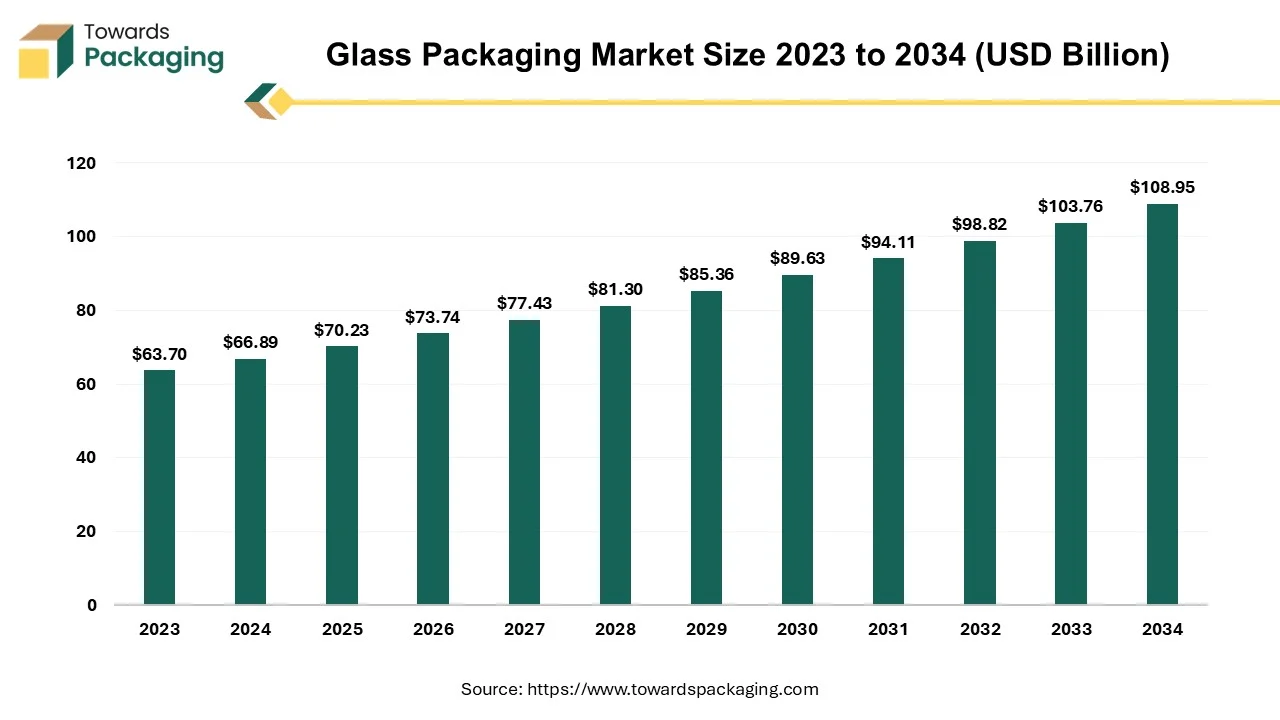
Glass packaging has been used for centuries due to its durability, chemical stability, and premium appeal. It remains a popular choice for industries like food & beverages, pharmaceuticals, cosmetics, and premium seafood packaging. The glass packaging provides a 100% barrier against oxygen, moisture, and external contaminants, ensuring a longer shelf life. Protects sensitive contents like seafood, dairy, and medicines from spoilage. Often used for high-end products due to its luxurious look and feel. Glass packaging can be coloured, embossed, or customized for branding purposes.
AI-driven automation can streamline glass production by optimizing temperature, pressure, and speed in molding, reducing energy consumption. Predictive maintenance uses AI to analyze equipment performance and anticipate failures, reducing downtime and repair costs. Computer vision and machine learning can detect defects (cracks, bubbles, irregularities) faster and more accurately than manual inspection. AI can improve consistency in production by automatically adjusting processes based on real-time quality assessments. AI-integrated QR codes and NFC technology provide consumers with real-time product information, sustainability details, and recycling instructions.
AI-powered computer vision can detect defects such as cracks, bubbles, or irregularities in glass bottles and containers with greater accuracy than human inspection. Machine learning algorithms can continuously improve defect detection by analyzing past data and predicting manufacturing issues. AI can analyze sensor data to predict equipment failures before they happen, reducing downtime. AI-driven systems can adjust temperature, pressure, and speed in glass molding to optimize quality while minimizing energy consumption. AI-driven demand forecasting can help manufacturers produce the right amount of glass packaging, reducing overproduction and waste. Automated logistics management can optimize delivery routes and warehouse stocking, cutting costs and emissions.
Glass is chemically inert, making it ideal for storing medicines, vaccines, and injectable drugs. The expansion of biotechnology and specialty drugs is increasing the demand for borosilicate glass vials and ampoules. The pharmaceutical industry relies heavily on glass vials, ampoules, and syringes for storing vaccines, injectable drugs, and biologics. The growth of biopharmaceuticals, gene therapies, and specialty drugs increases the need for high-quality borosilicate glass that resists chemical interactions. Biologics and biosimilars require packaging that prevents contamination, and glass is preferred due to its inert properties and ability to maintain drug stability.
As personalized medicine and advanced therapies grow, customized glass packaging solutions will be in higher demand. Rising healthcare spending in developing countries (India, China, Brazil) is increasing the production of pharmaceuticals, fueling demand for glass packaging. The aging population worldwide is driving demand for injectables, IV solutions, and ophthalmic products, all of which rely on glass packaging. The expansion of the pharmaceutical and healthcare industries is directly boosting the demand for glass packaging, especially for vials, ampoules, and high-quality containers used in medicine storage.
According to the data published by the Indian Pharmaceutical Association, in 2025, it has been estimated that according to an investigation by ETMutual Funds, mutual funds focused on pharmaceutical and healthcare have provided the highest average return in 2024 (January 1, 2024 to December 3, 2024), at about 38.05%.
The pharmaceutical glass packaging market is anticipated to grow from USD 23.23 billion in 2025 to USD 49.62 billion by 2034, with a compound annual growth rate (CAGR) of 8.8% during the forecast period from 2025 to 2034.
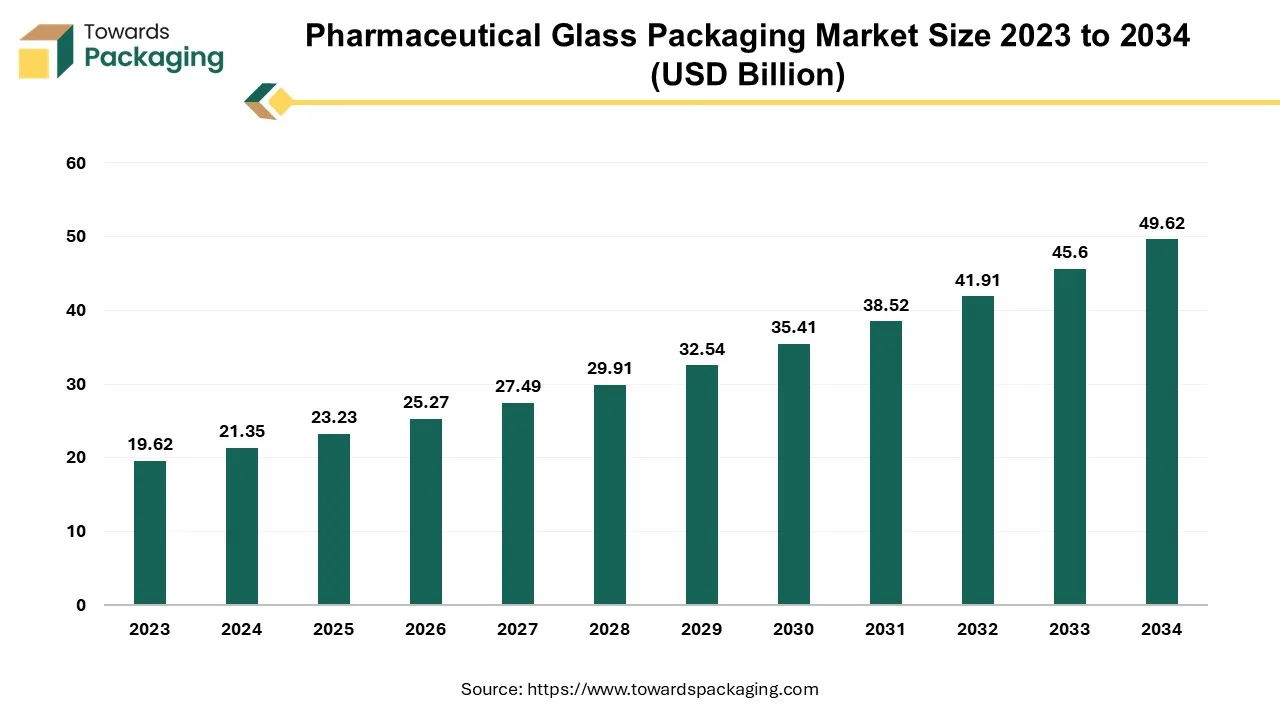
Glass has long been the main material used in the pharmaceutical packaging industry because of its remarkable qualities. Glass is a great material to store drugs in solid, liquid, injectable, or reconstitution form because of its chemical stability and inertness. The medications' purity and integrity are guaranteed to last due to its non-reactive nature, even in the presence of other compounds or chemicals. Glass also has a strong resilience to temperature changes, which is important in the pharmaceutical industry because pharmaceutical items frequently need certain storage conditions. This resilience is especially useful for preserving the integrity of the packaging during procedures like sterilisation, freezing, or freeze-drying.
The key players operating in the market are facing issue due to fragility of glass material and competition from alternative packaging materials which has estimated to restrict the growth of the glass packaging market. Glass production requires extremely high temperatures, leading to higher energy consumption and costs, especially with rising fuel prices. Some segments prefer plastic pouches, cartons, or metal cans due to cost-efficiency and convenience.
Glass is more fragile than plastic or metal, leading to higher breakage risks during transport and storage. Although glass is sustainable, its manufacturing process emits significant CO₂, making it less eco-friendly compared to some alternatives. Consumers often prefer lightweight and shatterproof packaging, making plastic or aluminum more appealing for on-the-go products. Advances in biodegradable plastics and compostable packaging present competition to glass.
Growing concerns about plastic waste and pollution are pushing brands to switch to glass, which is 100% recyclable and reusable. Government policies & regulations: Many countries are introducing plastic bans and recycling mandates, encouraging industries to adopt glass packaging. Circular economy initiatives: Glass can be recycled endlessly without losing quality, aligning with sustainability goals of major corporations.
Manufacturers are developing lightweight glass to reduce transportation costs and carbon emissions. Smart glass packaging (e.g., NFC-enabled bottles, QR codes) is gaining traction, offering enhanced customer engagement and traceability. For instance, in 2023, SGD Pharma, pharmaceutical company revealed the expansion of the beauty and cosmetics range with the launch of the Nova - a lightweight glass bottle.
Canned Glass Packaging Market Growth Drivers, Challenges and Opportunities
The canned glass packaging market is projected to reach USD 10.09 billion by 2034, growing from USD 7.31 billion in 2025, at a CAGR of 3.65% during the forecast period from 2025 to 2034.
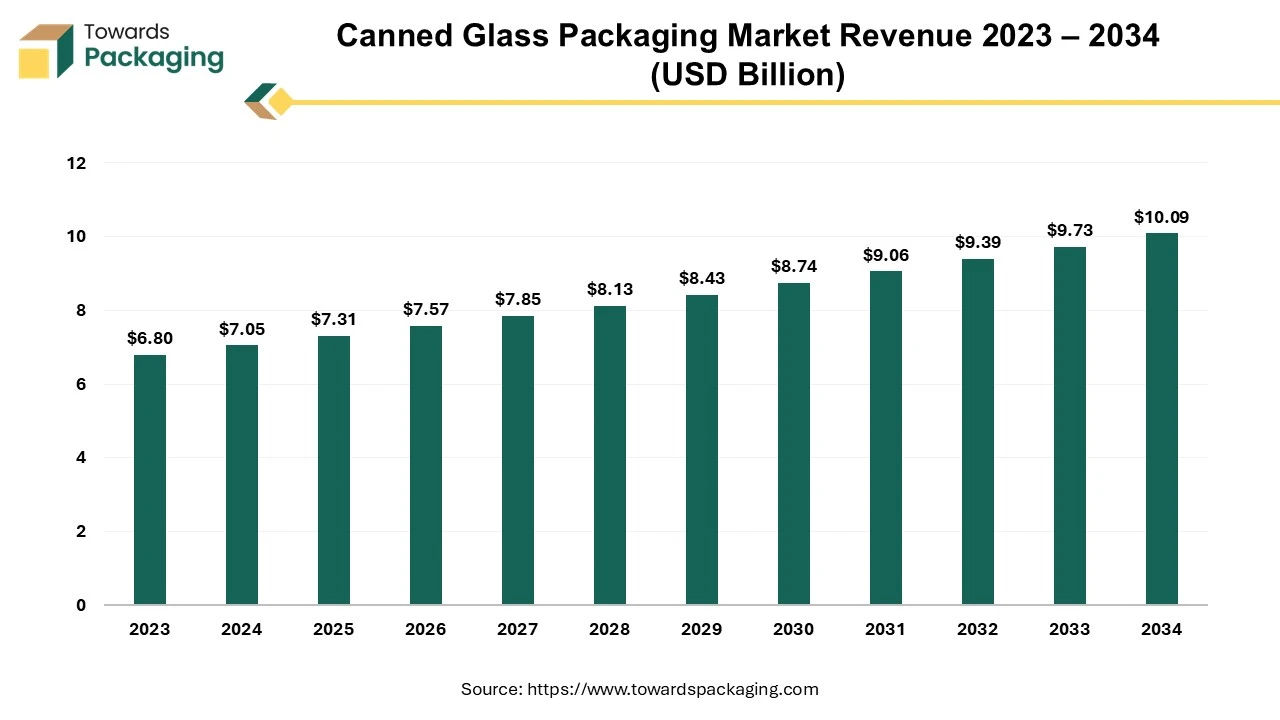
The market is proliferating due to the increasing demand for packed pickles, milk, jam, and various such food and beverages industry, and pharmaceutical industries which demand safe and contamination-free packaging of drugs and vaccines. This eco-friendly and safe packaging demand in several industries significantly drives the canned glass packaging market.
The soda-lime glass segment held a dominant presence in the glass packaging market in 2024. Soda-lime glass is cheaper to manufacture compared to other types like borosilicate glass, making it the preferred choice for mass production. Transparent and color-customizable of soda-lime glass making it ideal for packaging and display. Soda-lime glass has low melting point (compared to borosilicate glass) makes it easier to mold and shape.
The vials segment accounted for a significant share of the glass packaging market in 2024. Glass is extensively used for manufacturing vials due to its unique properties that ensure the safety, stability, and effectiveness of stored substances. As glass has chemical inertness & non-reactivity. Glass does not react with drugs, vaccines, or chemicals preventing contamination. The glass material offers thermal resistance can withstand high-temperature sterilization processes (autoclaving). The glass material is suitable for cryogenic storage and transport of temperature-sensitive drugs.
The drugs glass packaging market is expected to increase from USD 5.51 billion in 2025 to USD 8.17 billion by 2034, growing at a CAGR of 5.05% throughout the forecast period from 2025 to 2034.
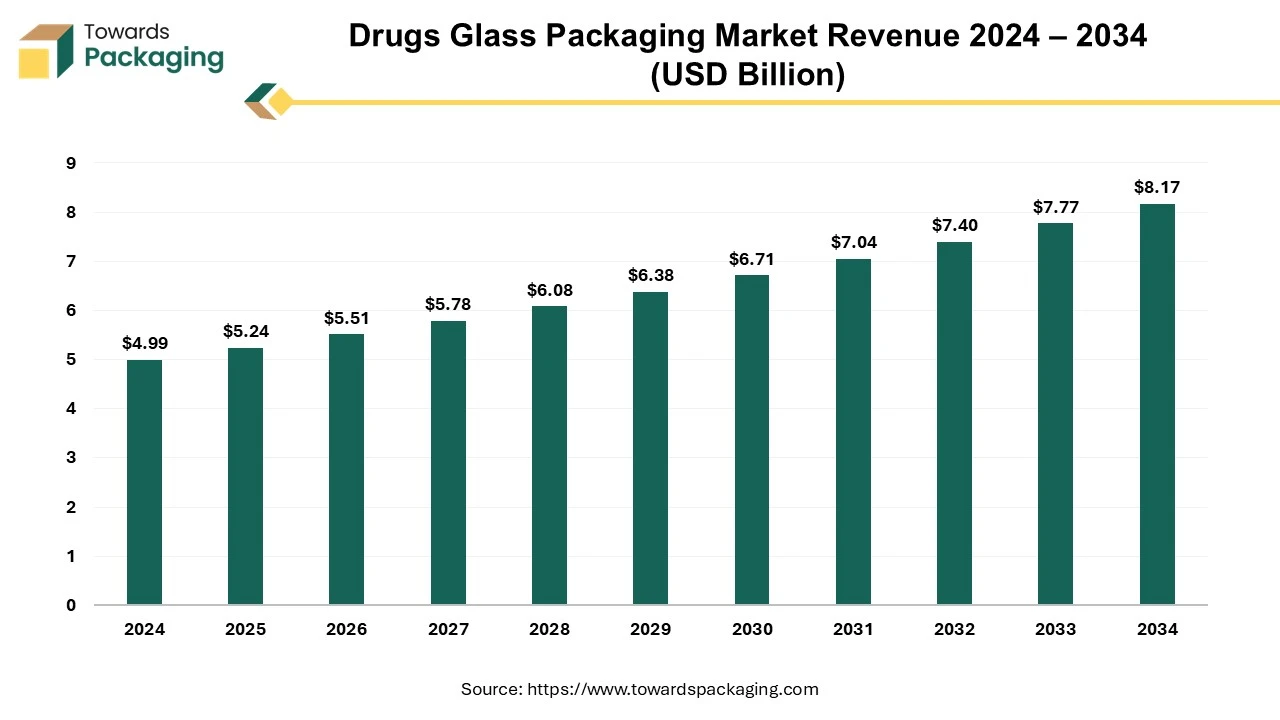
The market is proliferating due to the increasing pharmaceutical industries due to continuous research and funding. These drugs need safe contamination-free packaging which can also enhance the shelf life of the products. This eco-friendly, safe and sustainable packaging demand in several industries significantly drives the drugs glass packaging market.
The drugs glass packaging market is an important industry in the healthcare packaging sector. This deals with sustainable packaging and transporting medicinal glass packaging to several areas. This market is generally driven by the rising trend of eco-friendly packaging and reliable glass packaging demand among consumers which should also be convenient. The drugs glass packaging industry manufactures different types of glass bottles with various requirements such as shapes, sizes, quality, locking systems, and many others
The food & beverages segment registered its dominance over the global glass packaging market in 2024. As companies expand, they introduce more products requiring glass packaging (e.g., sauces, juices, dairy products, alcoholic drinks). Increasing consumer preference for premium and organic foods boosts glass usage due to its perceived purity and safety. The wine, beer, and spirits industry relies heavily on glass bottles for preserving taste and quality. Expanding breweries and distilleries increase the demand for customized and sustainable glass bottles.
The beer glass packaging market is set to grow from USD 42.44 billion in 2025 to USD 58.59 billion by 2034, with an expected CAGR of 3.65% over the forecast period from 2025 to 2034.
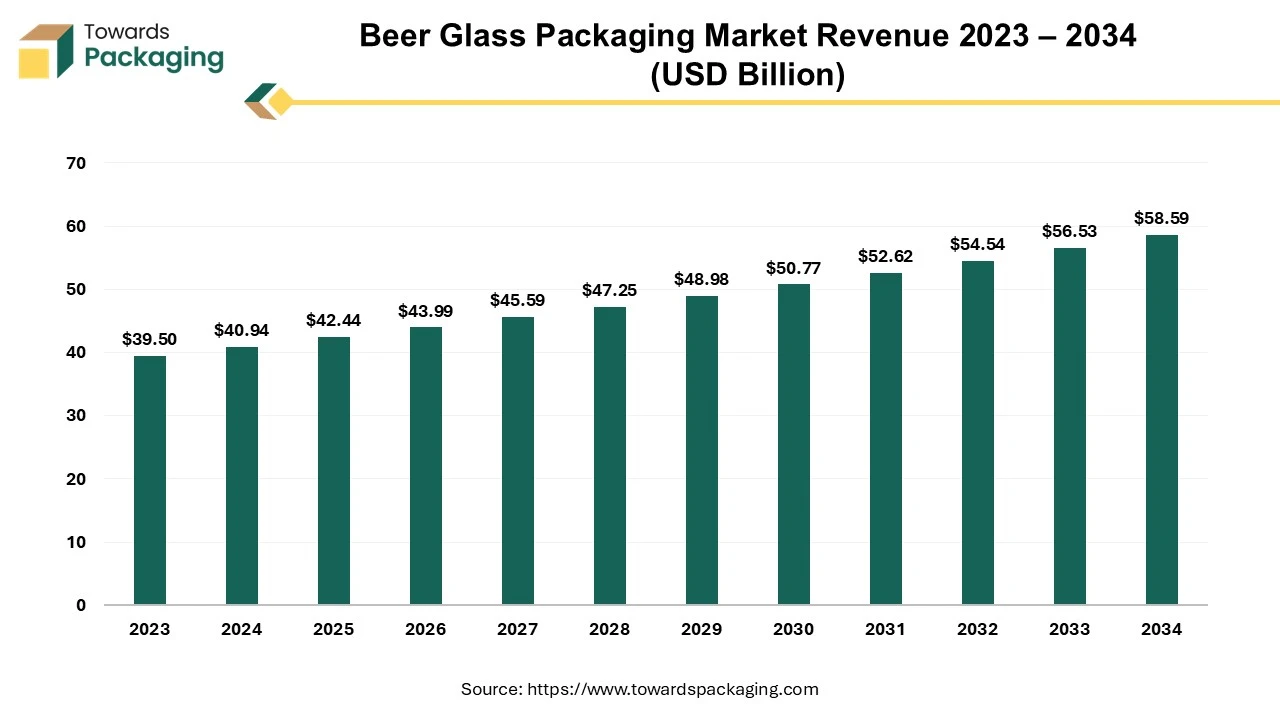
The market is proliferating due to the increasing demand for alcoholic beverages in celebrations. Consumers' demand for eco-friendly packaging is pushing the beer glass packaging market.
The beer glass packaging market is an important industry in the packaging sector. This deals with sustainable packaging and transporting beer bottles to several areas. This market is generally driven by the rising trend of premium-looking bottle demand among consumers which should also be convenient to use. The beer glass packaging industry deals with manufacturing different types of bottles with a variety of shapes, sizes, colors, locking systems, and many others. This industry manufactures different quality glass bottles with a variety of designs which makes it different from one brand to another. These bottles are of different types according to their weight as well. As there is a huge demand for lightweight glass bottles the growth factor of this industry is exponential.
The alcoholic beverage glass packaging market is expected to increase from USD 43.94 billion in 2025 to USD 60.67 billion by 2034, growing at a CAGR of 3.65% throughout the forecast period from 2025 to 2034.
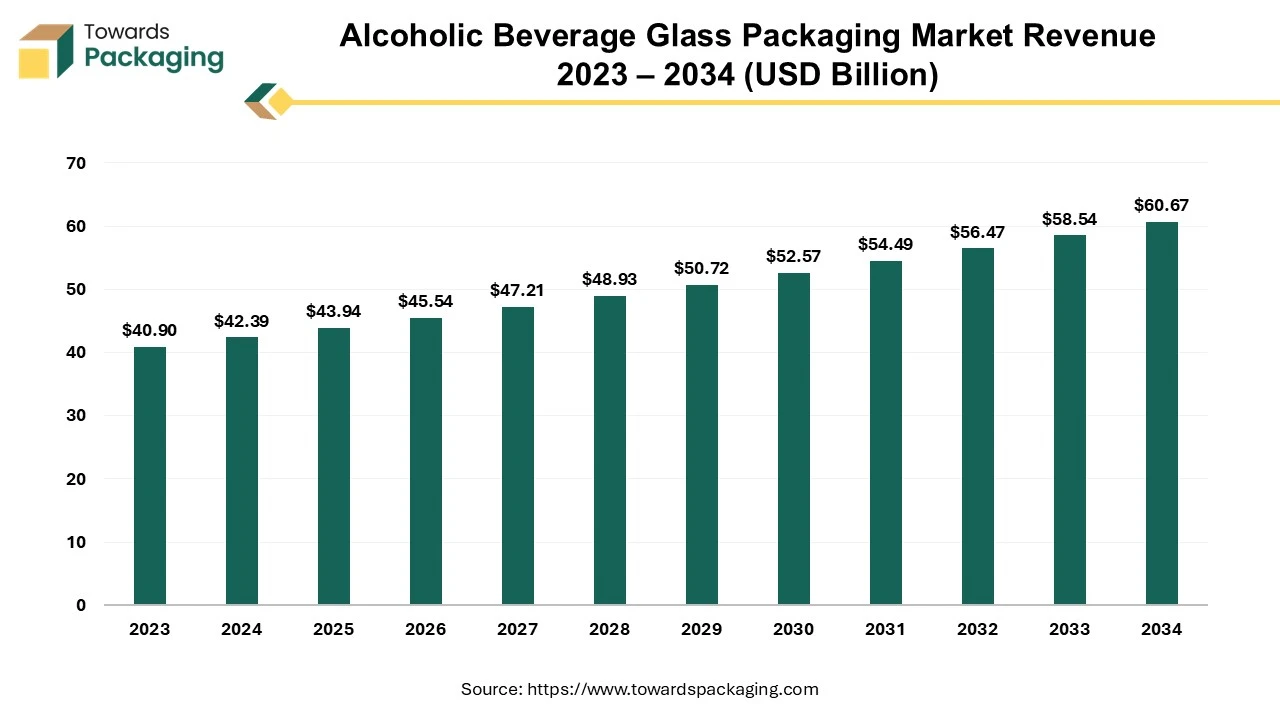
The market is proliferating due to the increasing consumption of alcoholic beverages by people for celebrations, high disposable earnings, societal demand, and many other factors. Consumers' continuous demand for eco-friendly packaging is pushing the alcoholic beverage glass packaging market.
Asia Pacific region dominated the global glass packaging market in 2024. This increase is explained by the growing need for environmentally friendly and sustainable packaging options because glass is a 100% recyclable material that has a smaller environmental impact. Furthermore, the expansion of the food, beverage, and pharmaceutical sectors in the area is increasing demand for long-lasting, safe, and high-quality glass packaging. Further encouraging market expansion are cutting-edge technology and packaging designs that improve the visual attractiveness of glass items.
The demand for glass packaging in India has increased due to shifting lifestyles, increased disposable incomes, and growing westernization, especially in the food and beverage and alcoholic beverage sectors. Additionally, as glass is the ideal material for products like ampoules, dropper bottles, and high-end cosmetic containers, the expanding healthcare and cosmetics industries have helped to fuel the need for glass packaging.
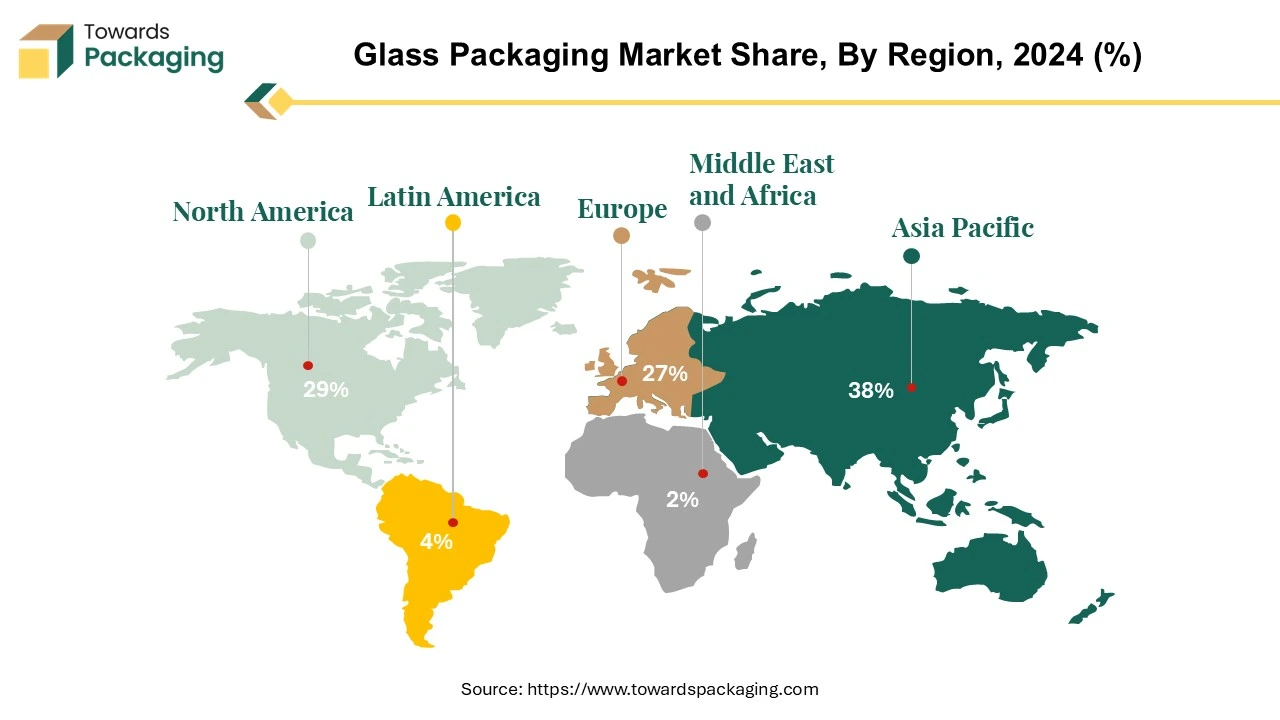
North America region is anticipated to grow at the fastest rate in the glass packaging market during the forecast period. North America region has a high consumption of alcoholic beverages, especially beer, wine, and spirits, which are often packaged in glass bottles due to their premium appeal and ability to preserve taste. Increasing awareness about environmental sustainability has led to a preference for glass, as it is 100% recyclable and reusable without losing quality. The pharmaceutical and personal care industries in North America rely on glass packaging for its chemical resistance, safety, and aesthetic appeal.
The U.S. glass packaging market is anticipated to increase significantly during the over the forecast years. The market is being driven in large part by the growing demand for eco-friendly and sustainable packaging options as a result of consumers' increased environmental consciousness. Due to glass's inert and non-reactive qualities, the pharmaceutical industry is seeing an increase in demand for glass packaging, which is fueling market expansion. It is anticipated that the need for glass packaging will be fueled by the aging of the American population and the concurrent growth of the pharmaceutical sector.
The U.S. glass packaging market is set to grow from USD 9 billion in 2025 to USD 12.8 billion by 2034, with an expected CAGR of 4% over the forecast period from 2025 to 2034. Increasing customer consciousness regarding sustainability and health has boosted the demand for glass packaging, particularly in the food and beverage industry.
Technological progressions, such as lightweighting and improved design competencies, are driving the U.S. glass packaging market development. The Midwest U.S. is dominating due to the increasing demand for eco-friendly and sustainable packaging results.
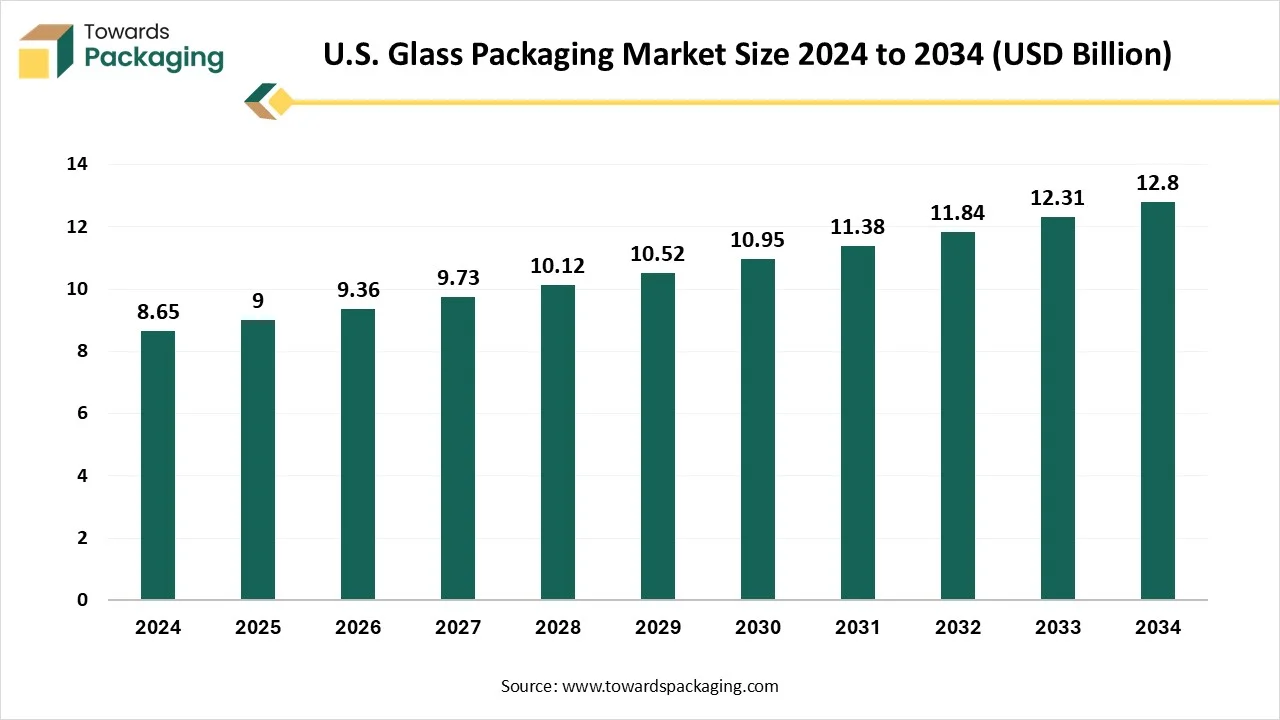
The market for glass packaging in Canada is anticipated to expand considerably as a result of rising beer consumption. Glass bottles are widely used to protect beer's contents from UV light exposure. Glass bottles and containers are also in high demand due to the growing popularity of cosmetics and fragrance goods, especially high-end and luxury brands. A competitive advantage for the expansion prospects of the sector is also provided by Canada's position as a major exporter of glass and glassware.
Europe region is seen to grow at a notable rate in the foreseeable future. The EU has implemented stringent policies to reduce plastic waste and promote circular economy practices, driving demand for glass as a sustainable packaging solution. Europe has one of the highest glass recycling rates globally, with countries like Germany, France, and the Netherlands leading in glass collection and reuse. This supports cost-effective and sustainable glass production. European consumers are highly conscious of sustainability, leading to a growing preference for glass over plastic, especially in food, beverages, and cosmetics.
The increasing consumption of wine, beer, and premium spirits, particularly in countries like Italy, France, and Spain, is driving the demand for glass bottles. European manufacturers are investing in advanced technologies to produce lightweight yet durable glass bottles, reducing costs and carbon emissions while maintaining strength and aesthetics. European governments and packaging companies are working together to enhance glass recycling infrastructure and encourage glass usage through incentives and funding programs.
| Country | Trade Flow | Trade Value (US$) | Net Weight (kg) | Quantity (u) |
| Argentina | M | $37,442,115 | 0 | 0 |
| Argentina | X | $20,164,450 | 32,103,053.50 | 32,103,054 |
| Brazil | M | $168,607,873 | 123,149,938.50 | 123,149,938 |
| Brazil | X | $24,597,970 | 9,012,426.40 | 9,046,833 |
| Colombia | M | $81,205,272 | 45,616,583.40 | 45,616,583 |
| Colombia | X | $26,582,084 | 16,549,613 | 55,448,044 |
| Country | Trade Flow | Trade Value (US$) | Net Weight (kg) | Quantity (u) |
| Australia | M | $106,419,200 | 0 | 91,575,252 |
| Australia | X | $9,568,045 | 8,109,047 | 7,560 |
| China | M | $63,299,522 | 14,403,944.50 | 14,403,945 |
| China | X | $3,078,789,499 | 2,152,908,438.20 | 2,152,908,438 |
| Sri Lanka | M | $7,080,725 | 7,969,751 | 7,969,751 |
| Sri Lanka | X | $23,711,482 | 37,014,744.70 | 37,014,745 |
| Indonesia | M | $99,782,983 | 101,274,206 | 101,274,206 |
| Indonesia | X | $48,517,125 | 67,228,047.30 | 67,228,047 |
| India | M | $113,191,440 | 129,201,879 | 129,201,879 |
| India | X | $424,416,380 | 406,666,358.90 | 406,666,359 |
| Singapore | M | $30,915,187 | 20,875,835.30 | 20,875,835 |
| Singapore | X | $7,862,855 | 1,163,348.30 | 1,163,348 |
| Country | Trade Flow | Trade Value (US$) | Net Weight (kg) | Quantity (u) |
| Belgium | M | $655,857,907 | 781,583,259.70 | 781,583,260 |
| Belgium | X | $262,679,420 | 175,613,135.90 | 175,613,136 |
| Denmark | M | $103,022,327 | 76,586,531.70 | 76,586,532 |
| Denmark | X | $76,460,959 | 73,763,405 | 73,763,405 |
| Finland | M | $51,670,033 | 49,508,256.70 | 49,508,257 |
| Finland | X | $273,189 | 131,770.70 | 131,771 |
| France | M | $1,880,879,109 | 0 | 0 |
| France | X | $955,920,535 | 0 | 0 |
| Germany | M | $640,850,091 | 444,827,207.60 | 444,827,208 |
| Germany | X | $1,657,628,375 | 1,422,934,979.20 | 1,422,934,979 |
| Greece | M | $202,091,620 | 254,675,038 | 254,675,038 |
| Greece | X | $20,451,749 | 23,755,509 | 23,755,509 |
| Italy | M | $1,016,434,578 | 1,076,656,449.30 | 1,076,656,449 |
| Italy | X | $1,034,392,602 | 424,850,435.90 | 424,850,436 |
| Country | Trade Flow | Trade Value (US$) | Net Weight (kg) | Quantity (u) |
| Israel | M | $90,779,000 | 76,736,649.50 | 76,736,650 |
| Israel | X | $401,000 | 309,890.30 | 309,890 |
| Saudi Arabia | M | $71,918,280 | 52,755,124.10 | 52,755,124 |
| Saudi Arabia | X | $68,553,522 | 131,191,462 | 131,191,462 |
| Turkey | M | $106,024,265 | 70,057,108 | 70,057,108 |
| Turkey | X | $215,065,718 | 431,084,958 | 431,084,958 |
| Country | Trade Flow | Trade Value (US$) | Net Weight (kg) | Quantity (u) |
| Canada | M | $398,948,216 | 0 | 0 |
| Canada | X | $115,867,815 | 107,158,813.30 | 107,158,813 |
| USA | M | $1,865,268,274 | 1,607,149,214.80 | 1,607,149,215 |
| USA | X | $349,933,610 | 321,089,041.10 | 321,089,041 |
| Country | Trade Flow | Trade Value (US$) | Net Weight (kg) | Quantity (u) |
| South Africa | M | $48,780,042 | 0 | 41,138,969 |
| South Africa | X | $66,023,211 | 60,737,089.40 | 60,737,089 |
| Egypt | M | $31,571,013 | 0 | 0 |
| Egypt | X | $93,994,958 | 86,080,890.80 | 86,080,891 |
| Country | Trade Flow | Trade Value (US$) | Net Weight (kg) | Quantity (u) |
| Luxembourg | M | $15,573,823 | 32,971,919.30 | 32,971,919 |
| Luxembourg | X | $5,707,225 | 13,194,608.10 | 13,194,608 |
| Switzerland | M | $233,352,327 | 0 | 0 |
| Switzerland | X | $61,936,559 | 0 | 0 |
| Country | Trade Flow | Trade Value (US$) | Net Weight (kg) | Quantity (u) |
| New Zealand | M | $52,196,258 | 0 | 45,285,072 |
| New Zealand | X | $3,227,330 | 0 | 2,971,837 |
| Malaysia | M | $54,997,433 | 0 | 0 |
| Malaysia | X | $20,988,224 | 27,931,697.90 | 27,931,698 |
| Mexico | M | $128,816,432 | 0 | 0 |
| Mexico | X | $613,527,058 | 0 | 0 |
| Netherlands | M | $266,423,246 | 224,522,476.20 | 224,522,476 |
| Netherlands | X | $295,375,083 | 0 | 0 |
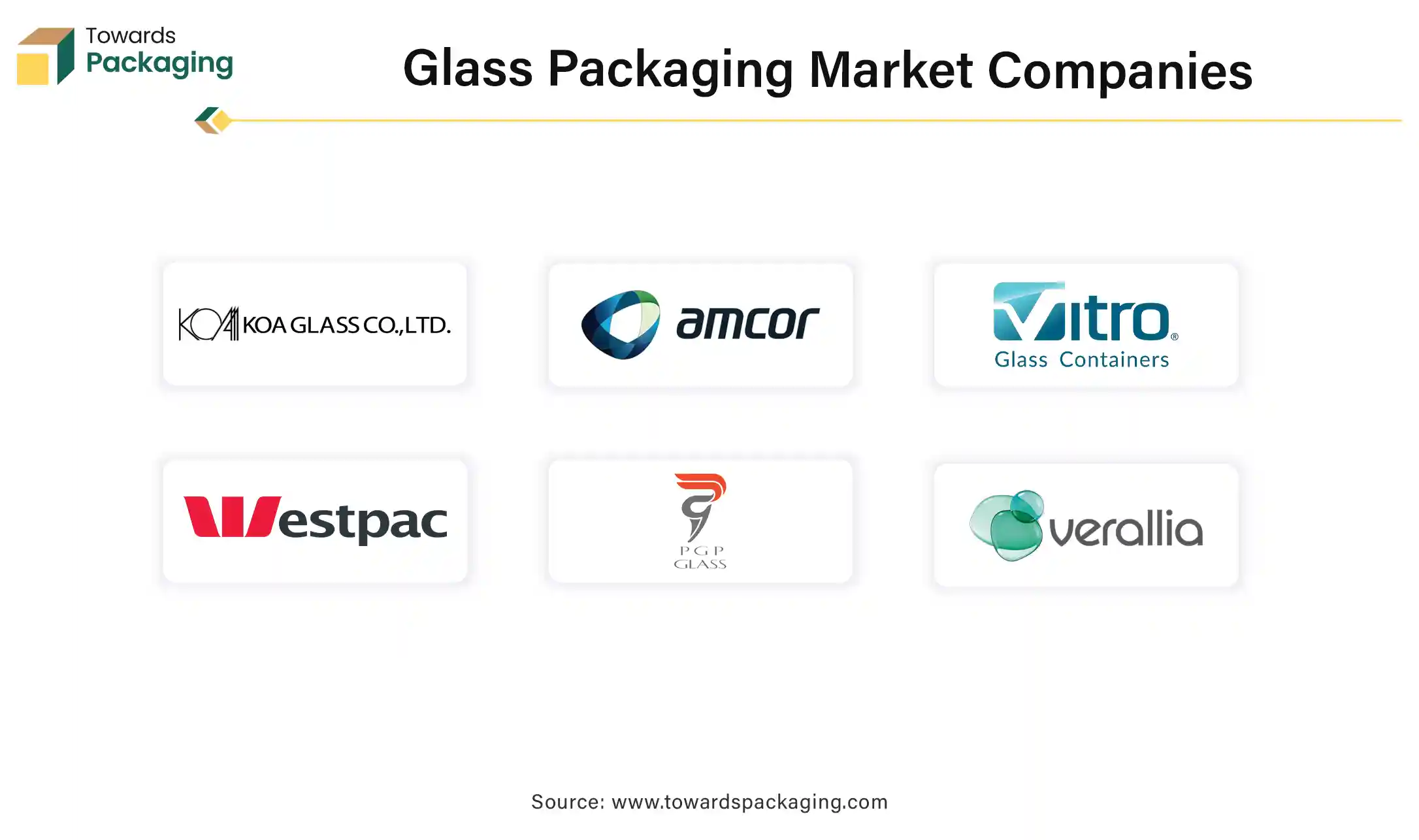
By Material
By Product
By Application
By Region
December 2025
December 2025
December 2025
December 2025